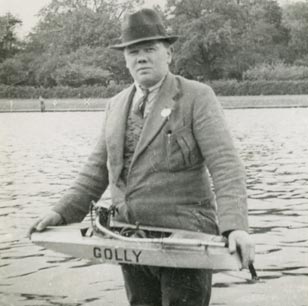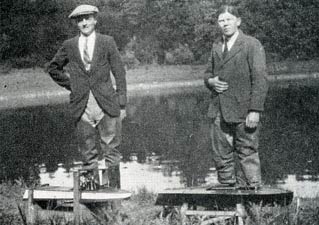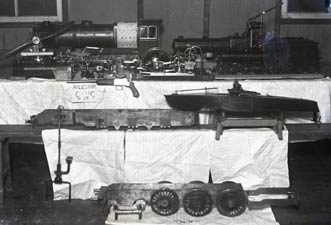

|
Home Updates Hydros Cars Engines Contacts Links Contact On The Wire Next→ |
Edgar Westbury

Tethered Hydroplanes
Whilst there have been many sizeable contributions to the world of tethered hydroplane racing over the last 100 years there can be no doubt that for a period of 20 years, those of Edgar T Westbury were the most extensive and significant. His name is irrevocably associated with an untold number of constructional, descriptive and general hydro related articles in Model Engineer, designs for engines and boats along with numerous accessories, as well as regatta reports and photographs. The views he expressed and some of his design principles did not always meet with universal acceptance, but this should not detract from his outright enthusiasm for, and desire to promote tethered hydroplane racing, especially through his time with the Model Power Boat Association.
|
Edgar Westbury’s life story and incredibly prolific work in model engineering and other spheres has been well documented by others, but having been given access by the Westbury family to the very extensive photographic and documentary archive he left, we now feel able to present a more detailed appreciation of his place in the history of tethered hydroplane racing. Edgar Thomas Westbury was born in 1896, almost exactly the same time as the racing of model speedboats started, so his life spanned the entire development of the sport through to what we recognise today. He joined the Royal Navy at the height of the First World War, serving on the battle cruiser New Zealand at the Battle of Jutland. Having left the Navy in 1922, Westbury spent two years in partnership as a consulting and general engineer before moving to RAF Cranwell in 1925 and then RAF Halton, as a civilian laboratory assistant at the RAF Apprentice Training School. Right: ETW in the engine room |
|
|
Shortly after arriving in Buckinghamshire, Westbury set out to make contact with other model engineers in the vicinity resulting in the creation of the ‘Aylesbury Gang’, a lose association of kindred spirits from the area. They had all the attributes of a flourishing society, without any officers, rules or ‘other palaver’ as he put it. The impression is also given that meetings, which were on a ‘show and tell’ basis, could be a little lively, although as Westbury put it in 1964 ‘rarely was a member of the gang seen to be under the affluence of incohol’. |
|
It was also in 1925 that Westbury produced the first of his many IC engine designs that would eventually see service in tethered hydroplanes throughout his lifetime and even well into the 1990s. The late Vic Collins holds the record for the fastest four-stroke engined hydro in this country, which used a motor of Westbury origins. Initially, Westbury’s main interest was the miniaturisation of ignition systems for the small IC motors that were already well established by the mid 20s. With his designs, he also endeavoured to improve performance, reduce weight and improve reliability. He always claimed that while his own boats were never the quickest, most of his successes were down to completing the runs where others had failed.
|
|
The first motor that Westbury produced was the Atom I, intended for aircraft use, followed in 1928 by a new engine based on this that he named Atom II. There were some experimental features incorporated in the engine and it is the first of his many designs that can be positively identified for use in a hydro. Left: Atom I. Right: Atom II |
|
|
Firstly, the reduction in capacity from 52cc to 30cc was to conform to the upper class limit for speedboat competition and secondly it is photographed on a set of bearers and in situ in a boat called Miss X. This was a metre long boat in true scow form as it had no step and was built by A.D Trollope of the Harrow Club. From later comments Westbury was already experimenting with tethered boats as he remarked that ‘my difficulties in producing a racing engine were complicated by further difficulties in getting a hull to stay upright’. Indeed, he goes on to say that Miss X, ‘after sundry trials (and tribulations) was re-christened ‘Miss Conduct’.’ |
|
Apart from his own enthusiasm, it does seem as if Westbury’s move into running tethered hydroplanes competitively was in response to him being challenged? There is a clue in an article published in ME in August 1930 where he acknowledges that he has his critics and detractors. He states, "One of the penalties one has to pay for setting up as a public oracle is that one is expected to uphold one’s reputation against all comers." He goes on to say that he is ‘accustomed to being addressed to this effect, either verbally or in writing’ along the lines of ‘You’re a good hand at giving away information on how to build engines for speedboats, but when are you going to set us a good example by winning the International?’ This may also explain how he became involved with the South London Model and Experimental Power Boat Club whilst still living at Aston Clinton, as one of his more vocal critics was SLEMPBC member and long time contributor to Model Engineer, Lionel (John) French.
Westbury does defend himself by offering ‘some explanation - or excuses’. He admitted to knowing nothing about hull design, which he considered to be at least as important as the motor, if not more so. He also commented that there was no suitable water within easy travelling distance. The first indication of what was to follow was a statement that "I have some hopes of doing a bit with a real speedboat of my own design and construction some day."
|
|
His first appearance as a competitor followed little more than a month after the above comments when he entered the 1930 International Race at Victoria Park on the 14th September. What leads to the suspicion of a challenge or an offer too good to refuse was that he was using a boat called ‘Also Ran’, that had been built by John French. The motor was not one of Westbury’s either, but an American Wall Junior. Westbury commented that he had no expectation of being able to compete but wanted to ‘demonstrate and active involvement in model speedboat racing’ and was ‘running this combination in order to gain experience’. |
However, his name did appear in the results finishing the 500-yard round the pole race in 79 seconds, a fraction under 13mph. One second behind was Ted Vanner with Leda V, whilst Gems Suzor won the race at 26mph. Westbury attributed the slowness of his run to leaves round the prop and skeg, a regular autumnal problem at Victoria.
|
|
Having found a small pond locally to run on, he considered that he ‘did manage to make a little progress’ with Miss X but that his aspirations suffered a ‘rude shock’ when he took the boat to London for MPBA competitions. He admitted to ‘doing almost everything wrong, and generally figured as the lame duck or comic relief of each event he entered’. The next boat that we can positively identify is ‘Miss Halton’, a large, single step craft, probably built around 1931, and as the name suggests, while Westbury was still at RAF Halton. |
|
This boat had the next of the family of 30cc two stroke motors installed, the Atom III.This version was the direct result of modifications required when his Atom II failed ‘in the course of a particularly exacting bench test’. At this time the two-stroke motor was very much in the shadow of the much more developed and faster single cylinder four-strokes, several of which were available commercially form the likes of Bonds, Grays, Gamages, Economic Electric etc. Right: Atom III from Miss Halton |
|
The hull of ‘Miss Halton’ was designed on the lines of a boat called ‘Newg II’. After being used for experiments during which it suffered many crashes, capsizes repairs and rebuilds, it was superseded by Miss Halton II. The second version was built by H A Cox, a well-known designer and contributor to Model Engineer, and based on the lines of the 15ft Bulldog racing boat built by the Brooke Company in Lowestoft. It was described in Model Engineer in 1934. Even this boat had something of a chequered career, snapping the line on its very first run and smashing into the concrete edging of the pond. Cox maintained that it was never quite the same boat after the repairs that Westbury was forced to make. Even so it was an improvement on the previous version, managing just over 20mph.
 |
 |
| With Miss Halton at the Halton Pond | Aylesbury Gang stand with Miss Halton II |
This was really the end to the first part of Westbury’s involvement with tethered hydroplanes as he left his post at Halton in 1932 to become Technical Assistant to Percival Marshall at Model Engineer, a post he was to hold until 1945 when he became Technical Editor.
|
|
This involved as he put it "big changes in personal fortune and locality (that) put an end temporarily, to all my workshop facilities and for three years my struggles to keep going with boats were quite futile." This also ‘finished his career in the 30cc class’ and while he would design further successful 30cc motors, all his future work was with smaller classes. He had concluded that handling ‘really lively’ 30cc boats was practically a two-man job. Left: Newspaper cutting from June 1932 showing Westbury (facing camera) spectating at a regatta. |
The brief statement about his personal circumstances disguises the true depth of the disruption to his life, which started with a move from Aston Clinton to take up the new post, closely followed by the death of his wife Winfred in 1934, leaving him with two young children. Eventually he settled in Brixton where the Westbury family was to remain until the attention of the Luftwaffe determined otherwise. By 1935, life had returned to something like normality as he had remarried.
|
Westbury returned to competition at the Swindon regatta in May 1935 with another boat built by H.A. Cox, this time called ‘Beryl’ after his second wife. This was a scaled down version of Miss Halton II to accommodate the 15cc Kiwi motor that he had designed and described in Model Engineer early in 1935. He hardly gave the boat a fair chance as he admits to completing the installation of the engine during the train journey and was not sure if the boat would run at all. It did manage to reach 17mph to win the class, which Westbury claimed as "my very first success in model power boating". |
|
|
|
The career of ‘Beryl’ was very short lived as another broken line, this time at Bournville in June, lead to almost complete destruction when a well meaning spectator rescued the boat with the motor still running and then dropped it back in the water only to see it smash head on into the concrete bank. Westbury did undertake ‘the well nigh impossible job of repairing the hull’, but the boat was never run again in competition. |
©copyrightOTW2014